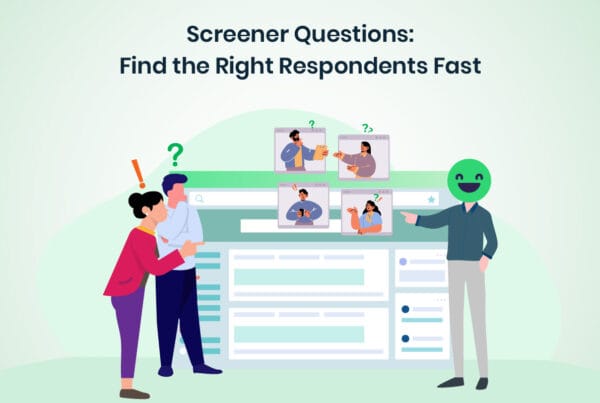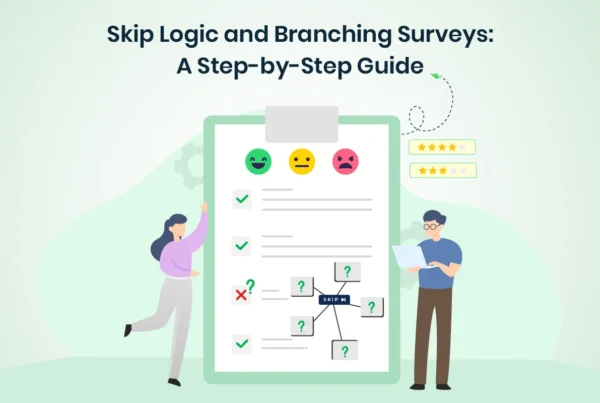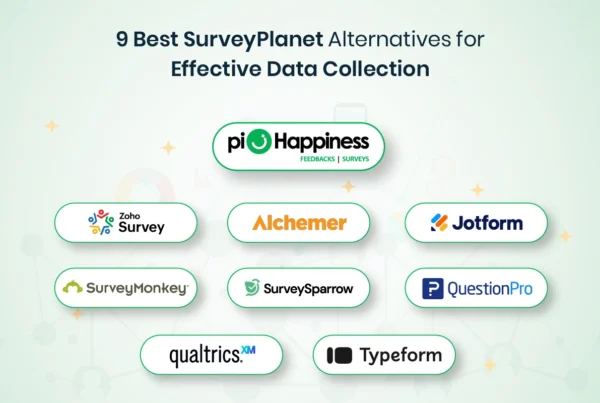In the digital age, customer feedback has become an invaluable resource for businesses seeking to thrive and adapt to ever-evolving market dynamics. Surveys, whether conducted through an online customer survey app or traditional methods, provide essential insights that drive informed decision-making. It also provides data such as customer preferences, employee satisfaction, market trends, and much more. However, the real power lies in how you analyze and act upon the survey results.
Unlock actionable insights with our survey analysis tools❤️
Transform feedback into smart, data-driven decisions for your business today!
Here are the 10 effective ways to analyze survey results and leverage them for making smart, data-driven business decisions.
What is Survey Analysis?
Survey analysis is the systematic examination of data collected from surveys to extract meaningful information and draw conclusions. It is a crucial step in understanding people’s opinions, behaviors, preferences, and attitudes. The ultimate goal of survey analysis is to convert the raw data into valuable insights that will guide decision-making. It is applicable in various fields, including business, research, healthcare, and public policy.
Define Clear Objectives:
Before conducting a survey, it’s crucial to define clear objectives. Customers always have varied perspectives on your services or products. So, think about what specific information you are seeking to obtain. Having well-defined objectives helps in designing targeted questions and collection of valuable data. It ensures that your data directly aligns with your business decision-making needs for potential growth. As there are multiple survey methods, Customer Effort Score (CES Survey) is one of the best service metrics for businesses to measure customer interactions. It shows how feasibly customers are interacting with your service or product.
Use Survey Software:
With the increasing demand for customer satisfaction, businesses are advised to use the popular customer survey software to track their experiences. Leverage survey software tools like SurveyMonkey, Google Forms, or Net Promoter Score (NPS survey) to streamline the data collection process. These tools not only make it easy to create and distribute surveys but also provide robust analytics features to help you interpret results.
Segment Your Data:
Segmentation allows you to break down survey responses. To understand the customer experience properly, the segmentation process is divided into different categories, such as demographics or purchase behavior. This enables you to identify patterns and trends within specific groups to identify the level of customer satisfaction. It can also lead to more tailored and effective decision-making.
Conduct Thorough Analysis:
Don’t just skim through survey responses. Conduct a thorough analysis to identify key insights. Always look for common themes, trends, and outliers in the data. You must consider utilizing data visualization tools like charts and graphs. This will help you to make complex data more understandable. For a change you can also conduct analysis using the QR code survey apps as it provides multiple ways to connect with customers and get their experiences.
Cross-Tabulate Data:
Cross-tabulation involves analyzing the relationship between two or more survey questions. This method helps you uncover correlations and dependencies between variables, which can be invaluable when making strategic decisions.
Prioritize Feedback:
Not all survey feedback is equally important. Prioritize responses based on their impact on your business goals. Focus on addressing issues or opportunities that will have the most significant influence on your decision-making. You can also streamline the data through email, SMS survey software, and more.
Benchmark Against Previous Surveys:
Benchmarking against previous surveys is an essential practice in survey analysis that allows organizations to gain valuable insights. By comparing current survey results with data collected in the past, businesses can measure progress, identify trends, and assess the effectiveness of past decisions. This historical context provides a basis for making data-driven decisions, refining approaches, and allocating resources more effectively.
It serves as a customer feedback survey loop for continuous improvement, ensuring that organizations remain responsive to changes in the market, preferences, or internal operations. In today’s dynamic digital age, benchmarking against historical survey data is a strategic asset that empowers businesses to adapt, thrive, and achieve better outcomes through informed decision-making.
Seek Expert Guidance:
Sometimes, interpreting survey results can be complex, especially when dealing with large datasets. Consider seeking the expertise of data analysts or statisticians who can provide deeper insights and ensure your decisions are well-informed.
Collaborate and Share Insights:
Collaboration and information sharing are integral components of effective decision-making within organizations. In the spirit of transparency, it’s. This practice ensures that decision-makers, teams, and departments are all well-informed. Furthermore, encouraging participation and input from diverse perspectives enriches the decision-making process, enabling organizations to draw upon a wealth of knowledge and expertise.
By promoting collaboration and insight-sharing, organizations can harness the collective wisdom of their teams, leading to more informed and well-rounded decisions that are poised for success.
Iterate and Adapt:
Lastly, remember that the business landscape is dynamic. The process of survey analysis doesn’t end with the initial data collection; it’s an ongoing journey. To stay relevant and responsive to changing circumstances, it’s crucial to embrace a culture of continuous improvement. This involves regularly revisiting and refining your survey strategy, ensuring that the questions you ask remain aligned with your evolving goals and objectives. By doing so, you can tap into the most up-to-date insights and trends. This allows your organization to make agile decisions that keep you ahead of the curve and thrive in the competitive business environment.
Characteristics of Survey data:
Survey research exhibits consistent characteristics, irrespective of its specific implementation:
Purposeful: Surveys serve as effective tools for collecting information about human behavior and attitudes.
Methodical: Survey research adheres to well-defined and systematic procedures, ensuring data collection is structured and organized.
Reproducible: When the same methods are employed repeatedly, survey research yields consistent and comparable results over time.
Versatile: Surveys can take various forms, accommodating both online and offline formats to suit diverse research needs.
Comprehensive: Survey research is capable of gathering both quantitative and qualitative data, offering a comprehensive understanding of the subject matter.
Types of Survey Data:
Online Survey Data:
Characteristics: Cost-effective, wide reach, real-time results, safe and secure, contactless.
Example: Guest satisfaction survey for a hotel chain.
Face-to-Face Survey Data:
Characteristics: High trust, honest Feedback, effective for sensitive topics, higher cost.
Example: In-person job evaluation surveys.
Telephone Survey Data:
Characteristics: Lower cost than face-to-face, convenient for remote interviewers, and potential anonymity.
Example: Telephone survey to understand purchasing decisions.
Paper Survey Data:
Characteristics: The pen-and-paper method is used where digital devices aren’t feasible to strengthen response validity.
Example: Fast-food restaurant feedback surveys.
Now, let’s categorize survey data based on the frequency of administration:
Cross-Sectional Survey Data:
Characteristics: Observational data collected at one point in time measures opinions in specific situations.
Example: Movie rental habits across demographics and locations.
Longitudinal Survey Data:
Characteristics: Extended data collection over time can be qualitative or quantitative, with no interference with respondents.
Example: Long-term study on the health of mine workers.
Retrospective Survey Data:
Characteristics: Data reported from the past provides in-depth insights and is quicker to complete. Example: Hiker feedback on a completed trek, including trail conditions and weather.
These categorizations help differentiate survey data based on collection methods and the timing of data collection. It provides researchers with various options to gather insights for their studies and decision-making processes.
Analyzing survey results is not just about collecting data; it’s about transforming that data into actionable insights. By following these ten effective ways to analyze survey results, you can make informed, data-driven decisions that lead to better outcomes for your business. Surveys become not just a tool for gathering information but a strategic asset for driving success in an ever-evolving business environment.
Frequently Asked Question:
1. What is survey analysis?
Survey analysis is the systematic examination of data collected from surveys to extract meaningful information and guide decision-making.
2. How can I ensure the success of a survey project?
To ensure a successful survey, start by defining clear objectives that align with your business needs. Use survey software to streamline data collection, segment your data, and conduct a thorough analysis to identify key insights.
3. What tools can I use for conducting surveys and analyzing the results?
Popular survey software tools like SurveyMonkey, Customer Satisfaction Score (CSAT surveys), and Net Promoter Score (NPS) can simplify the survey process.
4. Why is data segmentation important in survey analysis?
Data segmentation helps identify patterns and trends within specific groups, such as demographics or purchase behavior.
5. What is the significance of cross-tabulating survey data?
Cross-tabulation helps uncover relationships and dependencies between survey questions, which can be invaluable for making strategic decisions. It provides insights into how different variables interact.
6. How should I prioritize survey feedback for decision-making?
Prioritize survey responses based on their impact on your business goals. Focus on addressing issues or opportunities that will have the most significant influence on your decision-making.
7. Why is it important to benchmark current survey results against previous ones?
Benchmarking against past survey data helps assess the effectiveness of past decisions and adapt strategies accordingly. It provides insights into trends and changes over time, guiding ongoing decision-making.








